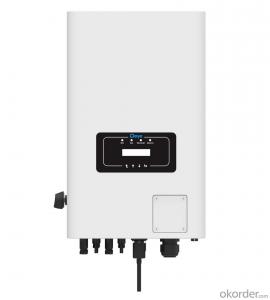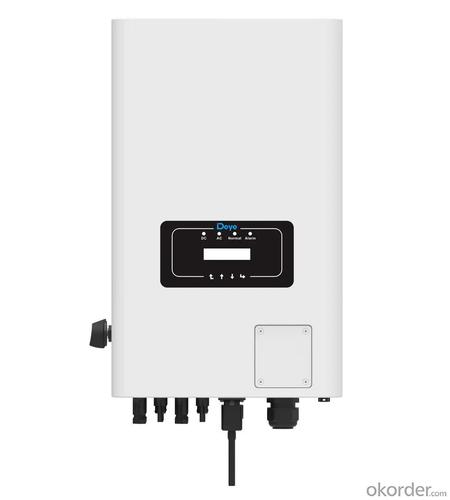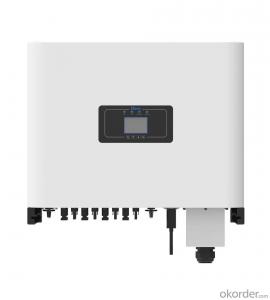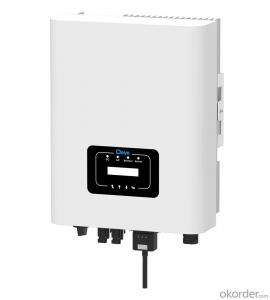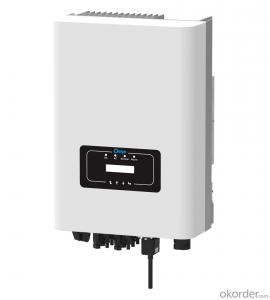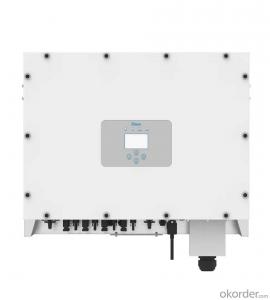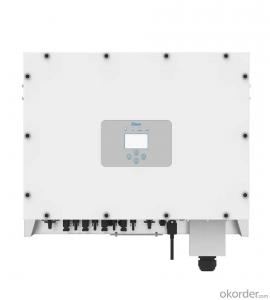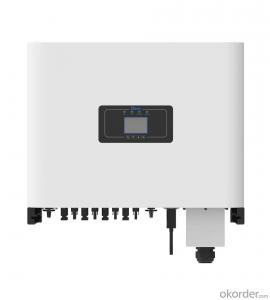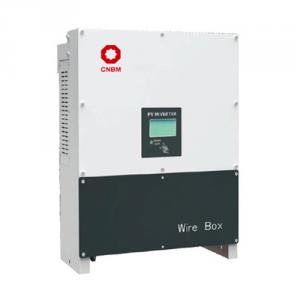Bosch Solar Inverter sun-30/33/36k-g04 | 30-36kw | Three Phase | 2 MPPT
- Loading Port:
- Ningbo
- Payment Terms:
- TT OR LC
- Min Order Qty:
- 100 pc
- Supply Capability:
- 5000 pc/month
OKorder Service Pledge
OKorder Financial Service
You Might Also Like
Specification
| Model | SUN-30K-G04 | SUN-33K-G04 | SUN-36K-G04 |
| Input Side | |||
| Max. DC Input Power (kW) | 39 | 42.9 | 46.8 |
| Max. DC Input Voltage (V) | 1000 | ||
| Start-up DC Input Voltage (V) | 250 | ||
| MPPT Operating Range (V) | 200~850 | ||
| Max. DC Input Current (A) | 40+40 | ||
| Max. Short Circuit Current (A) | 60+60 | ||
| Number of MPPT / Strings per MPPT | 2 / 4 | ||
| Output Side | |||
| Rated Output Power (kW) | 30 | 33 | 36 |
| Max. Active Power (kW) | 33 | 36.3 | 39.6 |
| Rated AC Grid Voltage (V) | 220 / 380, 230 / 400 | ||
| AC Grid Voltage Range (V) | 277Vac~460Vac (this may vary with grid standards) | ||
| Rated Grid Frequency (Hz) | 50 / 60 (Optional) | ||
| Operating Phase | Three phase | ||
| Rated AC Grid Output Current (A) | 43.5 | 47.8 | 52.2 |
| Max. AC Output Current (A) | 47.8 | 52.6 | 57.4 |
| Output Power Factor | 0.8 leading to 0.8 lagging | ||
| Grid Current THD | <3% | ||
| DC Injection Current (mA) | <0.5% | ||
| Grid Frequency Range | 47~52 or 57~62 (Optional) | ||
| Efficiency | |||
| Max. Efficiency | 98.6% | ||
| Euro Efficiency | 97.8% | ||
| MPPT Efficiency | >99% | ||
| Protection | |||
| DC Reverse-Polarity Protection | Yes | ||
| AC Short Circuit Protection | Yes | ||
| AC Output Overcurrent Protection | Yes | ||
| Output Overvoltage Protection | Yes | ||
| Insulation Resistance Protection | Yes | ||
| Ground Fault Monitoring | Yes | ||
| Anti-islanding Protection | Yes | ||
| Temperature Protection | Yes | ||
| Integrated DC Switch | Yes | ||
| Remote software upload | Yes | ||
| Remote change of operating parameters | Yes | ||
| Surge protection | DC Type II / AC Type II | ||
| General Data | |||
| Size (mm) | 362W×577H×215D | ||
| Weight (kg) | 25.5 | ||
| Topology | Transformerless | ||
| Internal Consumption | <1W (Night) | ||
| Running Temperature | -25~65℃ | ||
| Ingress Protection | IP65 | ||
| Noise Emission (Typical) | <45 dB | ||
| Cooling Concept | Smart cooling | ||
| Max. Operating Altitude Without Derating | 2000m | ||
| Designed Lifetime | >20 years | ||
| Grid Connection Standard | EN50549-1,VDE 0126-1-1 | ||
| Operating Surroundings Humidity | 0-100% | ||
| Safety EMC / Standard | IEC62109-1/-2,IEC61000-6-2,IEC61000-6-4 | ||
| Features | |||
| DC Connection | MC-4 mateable | ||
| AC Connection | IP65 rated plug | ||
| Display | LCD 1602 | ||
| Interface | RS485/RS232/Wifi/LAN | ||
This new series of three-phase output inverter has wider range of 30kw, 33kw, 36kw than the original series, at the same time still got two integrated MPPTs, allowing two-array to input from different roof orientations. In addition, it allows the system to be monitored and controlled remotely.
2 MPP tracker, Max. efficiency up to 98.6%
Zero export application, VSG application
String intelligent monitoring (optional)
Wide output voltage range
Anti-PID function (Optional)
- Q: How does a solar inverter handle voltage drop?
- A solar inverter handles voltage drop by continuously monitoring the voltage levels from the solar panels. It adjusts its output voltage accordingly to ensure that the electricity being produced is compatible with the grid or the appliances it is connected to. This helps to compensate for any voltage drop that may occur due to factors such as distance, resistance, or shading, thereby maintaining a consistent and stable power supply.
- Q: How do you connect a solar inverter to the electrical grid?
- To connect a solar inverter to the electrical grid, you need to follow a few steps. Firstly, you need to ensure that your solar inverter is compatible with grid connection. Then, you'll need to install an AC disconnect switch and connect it to your main electrical panel. Next, connect the solar inverter output to the AC disconnect switch using appropriate wiring. Finally, hire a licensed electrician to inspect and connect the inverter to the utility meter or main electrical service panel, ensuring compliance with local regulations and safety standards.
- Q: How does a solar inverter handle frequency variations in the grid?
- A solar inverter handles frequency variations in the grid by continuously monitoring the frequency and adjusting its own output accordingly. If the grid frequency increases, the inverter reduces its output to prevent overloading. Conversely, if the frequency decreases, the inverter increases its output to maintain a stable supply. This dynamic response ensures that the solar inverter efficiently synchronizes with the grid and contributes to grid stability.
- Q: How does a solar inverter handle fluctuations in solar panel output due to temperature changes?
- A solar inverter handles fluctuations in solar panel output due to temperature changes by incorporating a maximum power point tracking (MPPT) algorithm. This algorithm continuously adjusts the voltage and current levels to optimize the power output from the solar panels, compensating for any temperature-related variations. By dynamically adapting to temperature changes, the solar inverter ensures that the maximum power is extracted from the panels and efficiently converted into usable electricity.
- Q: Can a solar inverter be used with different types of tracking algorithms?
- Yes, a solar inverter can be used with different types of tracking algorithms. The inverter is designed to convert the DC power generated by solar panels into usable AC power for various applications. The tracking algorithm, on the other hand, is responsible for optimizing the solar panel's orientation to maximize energy production. Different tracking algorithms like fixed tilt, single-axis, or dual-axis can be employed with the solar inverter to enhance energy harvesting based on factors such as sun's position, time of day, and weather conditions.
- Q: Three-phase photovoltaic inverter grid, the use of phase-locked loop is what?
- Grid-connected inverter can be operated locally through the LCD screen, or through remote monitoring with dedicated monitoring software.
- Q: What is the role of a power limiter in a solar inverter?
- The role of a power limiter in a solar inverter is to regulate and limit the amount of power that can be generated and fed back into the electrical grid. It ensures that the solar system does not exceed the permitted power limits set by the utility company or regulatory authorities, preventing any potential damage to the grid infrastructure. Additionally, a power limiter helps maintain a stable and reliable power supply by controlling the amount of solar energy that is being exported or utilized within a specific threshold.
- Q: How does a solar inverter handle power quality issues in the grid?
- A solar inverter manages power quality issues in the grid by utilizing advanced control algorithms and technologies. It actively monitors the grid's voltage and frequency levels, and adjusts the output of the solar system accordingly to ensure compatibility and stability with the grid. This helps in mitigating power fluctuations, voltage sags or swells, and frequency deviations, thereby maintaining a high-quality power supply from the solar system to the grid.
- Q: Solar grid inverter does not merge into the grid, direct access to the load to the load power supply?
- Widely used in air conditioning, home theater, electric wheel, power tools, sewing machines, DVD, VCD, computer, TV, washing machine, range hood, refrigerator, video recorders, massage, fan, lighting and so on.
- Q: Generally a large grid-connected photovoltaic power plant will have several inverters
- Inverter, a single failure, does not affect other operations, the impact on the grid is small, high reliability.
Send your message to us
Bosch Solar Inverter sun-30/33/36k-g04 | 30-36kw | Three Phase | 2 MPPT
- Loading Port:
- Ningbo
- Payment Terms:
- TT OR LC
- Min Order Qty:
- 100 pc
- Supply Capability:
- 5000 pc/month
OKorder Service Pledge
OKorder Financial Service
Similar products
Hot products
Hot Searches
Related keywords
